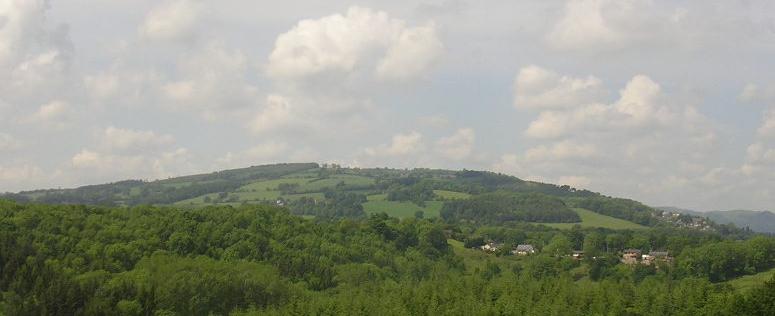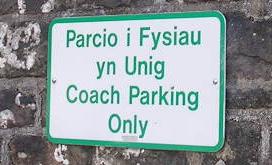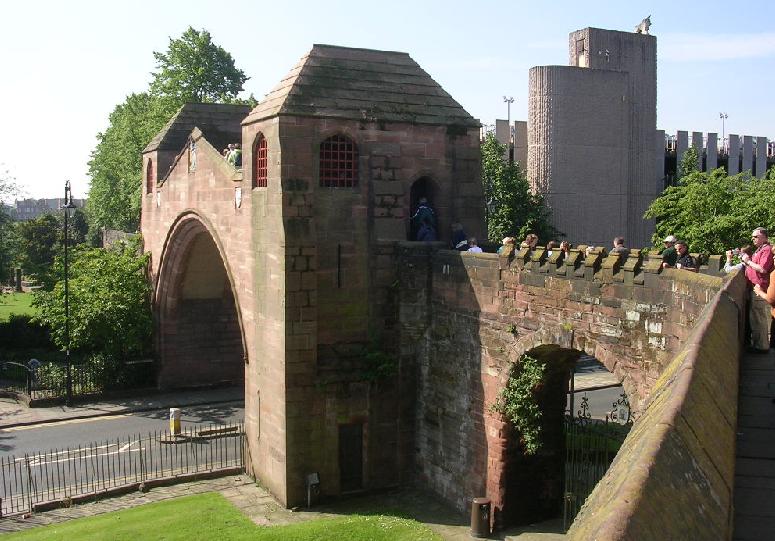We were back on the coach by a quarter after 11. Down Princess Street,
we crossed over the River Dee and were soon in the countryside again, zooming
down a 4-lane highway. There were tree-covered hills on both sides of the
highway. Many of them were actually old slag heaps from the coal mines
that closed in the 1980's. Our route that day would take us over the Welsh/English
border several times. We started seeing the red dragon of Wales on signs
everywhere. The signs started showing words in English and Welsh. Traffic
jams greeted us as we made our way down the A5 to Shrewsbury, the home
of Charles Darwin. More hills appeared. We headed south on the A49. We
saw farms with chickens, pigs... and more passing hikers.
 At the town of Ludlow, the huge coach squeezed its way through some impossibly
narrow streets to the town square, where we stopped for lunch. The square
itself was bustling with what looked like a flea market. There were canvas-covered
booths selling everything from CD's to fresh fruit to army surplus uniforms.
The town was completely charming, exactly what you'd imagine a little British
village to be on shopping day. Donna and I wandered through the market,
and I was sorely tempted to buy a couple of things, but we were hungry.
We stopped into a little shop called Aragon's and sat at a long wooden
table. Colin and Joan were already there. Colin had a glass of milk that
looked kind of foamy. He said he ordered a "milk shake." It looked like
they just took a glass of milk and shook it up! Donna and I shared
an English panini, and I had a Shropshire Lad beer– a "bitter," with 5%
alcohol, but smooth and very tasty. There was a castle adjacent to the
town square, but I only had time to get a couple of pictures before it
was time to catch the bus. By 2:20, we were on our way again, headed for
Hereford (pronounced "HARRAH-ford").
At the town of Ludlow, the huge coach squeezed its way through some impossibly
narrow streets to the town square, where we stopped for lunch. The square
itself was bustling with what looked like a flea market. There were canvas-covered
booths selling everything from CD's to fresh fruit to army surplus uniforms.
The town was completely charming, exactly what you'd imagine a little British
village to be on shopping day. Donna and I wandered through the market,
and I was sorely tempted to buy a couple of things, but we were hungry.
We stopped into a little shop called Aragon's and sat at a long wooden
table. Colin and Joan were already there. Colin had a glass of milk that
looked kind of foamy. He said he ordered a "milk shake." It looked like
they just took a glass of milk and shook it up! Donna and I shared
an English panini, and I had a Shropshire Lad beer– a "bitter," with 5%
alcohol, but smooth and very tasty. There was a castle adjacent to the
town square, but I only had time to get a couple of pictures before it
was time to catch the bus. By 2:20, we were on our way again, headed for
Hereford (pronounced "HARRAH-ford").
 We passed a town called Hope Under Dinmore. That sounded like a good title
for a book. From the distance we could see the cathedral of Hereford. There
was a funeral in progress at one little church. I saw lanes named Penhaligon
Way and Canonmore Street. Somebody on the coach passed around a bag of
chocolate. That was a very friendly thing to do. While passing the River
Rye, I saw someone fly fishing from a shallow bank. Many more fishermen
soon appeared. Further down the River Rye, about 4 PM, we stopped at the
ruins of Tinturn Abbey. I was ready for the coach to stop. The "new bus
smell" was the odor of industrial cleaners, and the air conditioning had
been blowing it in my face all day. I felt dizzy and nauseous. It was nice
to get out and walk around in the fresh air.
We passed a town called Hope Under Dinmore. That sounded like a good title
for a book. From the distance we could see the cathedral of Hereford. There
was a funeral in progress at one little church. I saw lanes named Penhaligon
Way and Canonmore Street. Somebody on the coach passed around a bag of
chocolate. That was a very friendly thing to do. While passing the River
Rye, I saw someone fly fishing from a shallow bank. Many more fishermen
soon appeared. Further down the River Rye, about 4 PM, we stopped at the
ruins of Tinturn Abbey. I was ready for the coach to stop. The "new bus
smell" was the odor of industrial cleaners, and the air conditioning had
been blowing it in my face all day. I felt dizzy and nauseous. It was nice
to get out and walk around in the fresh air.
 There's not much left of the abbey, but the impressive skeleton of the
12 Century church remained. It even inspired a poem by William Wordsworth.
There was a little shop around the corner where Donna and I got some Welsh
Gold ice cream. I felt a lot better after walking around for a while. Brien
took a picture of us next to the coach right before we departed. I sat
away from the air conditioning from then on. We crossed the River Severn
and back over the border into England. The road took us past docks on the
river banks and under the Clifton Suspension Bridge, which first opened
in 1864. For many years it served as a symbol of the city of Bristol. Queen
Elizabeth I used to visit Bristol. The post city of Bristol was another
British town heavily bombed during World War II and rebuilt as a modern
industrial city. It was 5:30 on a Friday afternoon, and traffic was awful.
The coach took us through the City Centre, which was dominated by a war
memorial and a big ugly sculpture. We pulled into the Marriott Hotel. We
got a very nice room, overlooking a park. The tour included supper in a
Bristol pub, so after an hour we all met down in the lobby.
There's not much left of the abbey, but the impressive skeleton of the
12 Century church remained. It even inspired a poem by William Wordsworth.
There was a little shop around the corner where Donna and I got some Welsh
Gold ice cream. I felt a lot better after walking around for a while. Brien
took a picture of us next to the coach right before we departed. I sat
away from the air conditioning from then on. We crossed the River Severn
and back over the border into England. The road took us past docks on the
river banks and under the Clifton Suspension Bridge, which first opened
in 1864. For many years it served as a symbol of the city of Bristol. Queen
Elizabeth I used to visit Bristol. The post city of Bristol was another
British town heavily bombed during World War II and rebuilt as a modern
industrial city. It was 5:30 on a Friday afternoon, and traffic was awful.
The coach took us through the City Centre, which was dominated by a war
memorial and a big ugly sculpture. We pulled into the Marriott Hotel. We
got a very nice room, overlooking a park. The tour included supper in a
Bristol pub, so after an hour we all met down in the lobby.
 The coach
took us to the nearby downtown area. We stopped at a place called the Llandoger
Trow –a 17th Century pub in the heart of Bristol. Robert Lewis Stevenson
used to be a customer, and possibly got inspiration there for his book
"Treasure Island." Another customer was writer Daniel Defoe, who met real-life
castaway Alexander Selkirk at the Llandoger Trow and used him as the inspiration
for "Robinson Crusoe." We all filed up the rickety narrow stairs to the
second floor. Upstairs, it was more of a restaurant than a pub. I got fish
and chips for the third time during our trip, but it was not the best of
the trip. Still, I had a Speckled Hen Beer, recommended by Nick, and followed
it up with a Black Thorn Cider. We all got to talk with each other during
the meal. The coach
took us to the nearby downtown area. We stopped at a place called the Llandoger
Trow –a 17th Century pub in the heart of Bristol. Robert Lewis Stevenson
used to be a customer, and possibly got inspiration there for his book
"Treasure Island." Another customer was writer Daniel Defoe, who met real-life
castaway Alexander Selkirk at the Llandoger Trow and used him as the inspiration
for "Robinson Crusoe." We all filed up the rickety narrow stairs to the
second floor. Upstairs, it was more of a restaurant than a pub. I got fish
and chips for the third time during our trip, but it was not the best of
the trip. Still, I had a Speckled Hen Beer, recommended by Nick, and followed
it up with a Black Thorn Cider. We all got to talk with each other during
the meal.
The street in front of the pub was full of college-age people. I kinda
wished we could've joined them. It would've added to the whole British
pub experience. After supper, several in the group decided to walk back
to the hotel rather than ride back. It was still light out. I watched a
little TV, then went on to bed. |




 Day 9:
I had dreams that night, but I don't remember what they were. I was up
at 5 AM. The shower had yet another wacky faucet, but with plenty of hot
water. By 6 AM, that first day of June, the Sun was well up in the English
sky. I washed a shirt in the sink the night before, but it wasn't dry yet.
The room came with a "trouser press," so I thought I'd see if it would
dry out the shirt. What happened was the whole thing broke away from the
wall. So, I went downstairs to report it. The night clerk almost laughed
when I told him. He also explained about Internet access. The computers
need codes to allow users online. The codes are printed on cards which
are sold to users at different rates for different lengths of time online.
All they had left to sell were 90 minute cards. That's why they couldn't
let me online the night before. If they'd just explained that to me, I
wouldn't have been so ticked off. The whole first floor of the hotel seemed
deserted that time of morning. I went back upstairs, where Donna made me
a hot chocolate. I felt better. The TV weather looked like it would be
warm and sunny that day.
Day 9:
I had dreams that night, but I don't remember what they were. I was up
at 5 AM. The shower had yet another wacky faucet, but with plenty of hot
water. By 6 AM, that first day of June, the Sun was well up in the English
sky. I washed a shirt in the sink the night before, but it wasn't dry yet.
The room came with a "trouser press," so I thought I'd see if it would
dry out the shirt. What happened was the whole thing broke away from the
wall. So, I went downstairs to report it. The night clerk almost laughed
when I told him. He also explained about Internet access. The computers
need codes to allow users online. The codes are printed on cards which
are sold to users at different rates for different lengths of time online.
All they had left to sell were 90 minute cards. That's why they couldn't
let me online the night before. If they'd just explained that to me, I
wouldn't have been so ticked off. The whole first floor of the hotel seemed
deserted that time of morning. I went back upstairs, where Donna made me
a hot chocolate. I felt better. The TV weather looked like it would be
warm and sunny that day.





 The coach
took us to the nearby downtown area. We stopped at a place called the Llandoger
Trow –a 17th Century pub in the heart of Bristol. Robert Lewis Stevenson
used to be a customer, and possibly got inspiration there for his book
"Treasure Island." Another customer was writer Daniel Defoe, who met real-life
castaway Alexander Selkirk at the Llandoger Trow and used him as the inspiration
for "Robinson Crusoe." We all filed up the rickety narrow stairs to the
second floor. Upstairs, it was more of a restaurant than a pub. I got fish
and chips for the third time during our trip, but it was not the best of
the trip. Still, I had a Speckled Hen Beer, recommended by Nick, and followed
it up with a Black Thorn Cider. We all got to talk with each other during
the meal.
The coach
took us to the nearby downtown area. We stopped at a place called the Llandoger
Trow –a 17th Century pub in the heart of Bristol. Robert Lewis Stevenson
used to be a customer, and possibly got inspiration there for his book
"Treasure Island." Another customer was writer Daniel Defoe, who met real-life
castaway Alexander Selkirk at the Llandoger Trow and used him as the inspiration
for "Robinson Crusoe." We all filed up the rickety narrow stairs to the
second floor. Upstairs, it was more of a restaurant than a pub. I got fish
and chips for the third time during our trip, but it was not the best of
the trip. Still, I had a Speckled Hen Beer, recommended by Nick, and followed
it up with a Black Thorn Cider. We all got to talk with each other during
the meal.